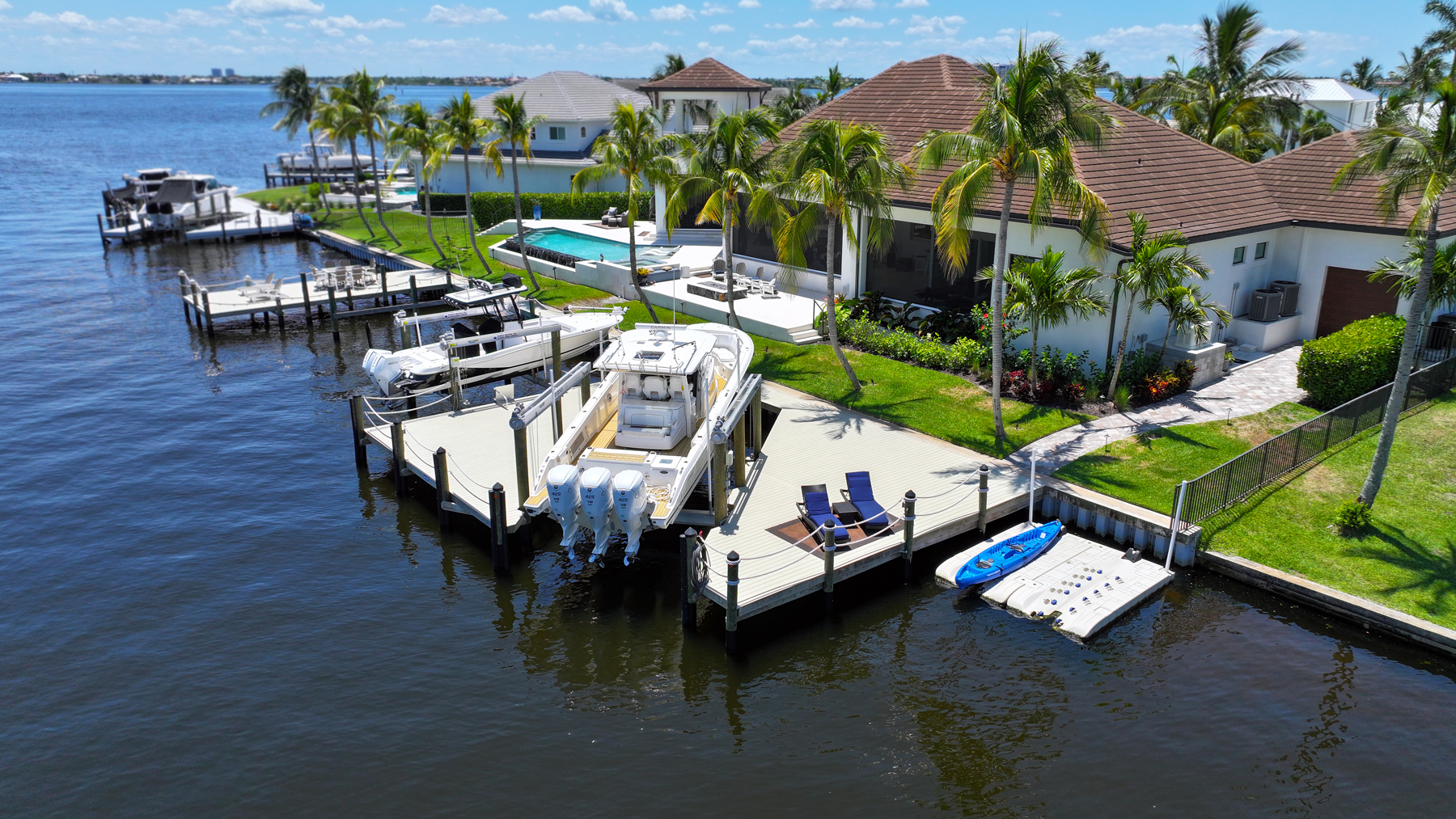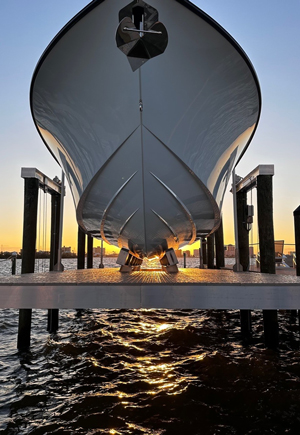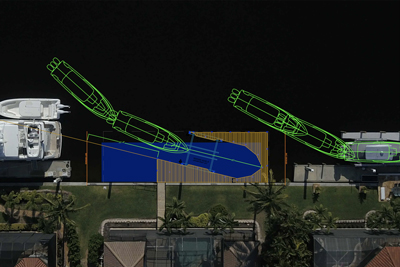The Ultimate Guide to a Well-Designed Dock: Essential Attributes for Waterfront Living

For waterfront homeowners and residents of Southwest Florida, there is nothing like walking out to a dock you just can’t get enough of. A well-designed dock can truly transform your boating and waterfront experience! Done correctly, the right dock adds incredible convenience, safety, and a touch of luxury to your property. In this guide, we’ll walk you through the key features that make a dock exceptional and why these elements are so important. From ideal slip dimensions to preserving your stunning views, we’ll show you what to look for to make the most of your waterfront lifestyle, as well as some items you may not have thought of.
Optimal Slip Length and Width
Even the most seasoned of boaters prefer to dock their boat with ease, particularly without the hassle of tight spaces or the worry of potential damage. This is why getting the slip dimensions right for your boat is crucial. Proper slip length and width make docking easy and stress-free, preventing damage and ensuring a smooth experience every time. This convenience isn't just a luxury; it's essential for protecting your investment.
Pro Tip – Give Yourself Room to Grow: The greater area of concern to consider would be the next boat you purchase. We often ask our clients if they plan on purchasing a larger boat in the future. We know the feeling of loving our boat but having eyes for something larger. It is much better to plan for the future purchase of a larger boat by having a long enough slip than to have to go back to give yourself enough space.
Water Depth and Obstructions
In Southwest Florida, where tidal changes are common and the bed of every canal varies from location to location, it’s essential to ensure your dock is properly configured and equipped to address potential concerns lying beneath the surface. Your dock design should consider things like tide levels to prevent grounding and canal profile to determine the type of cradle to use.
Pro Tip – Switch It Up: Imagine thinking you’ve got more room to drop your boat down and you decide to override your lower limit set (if you have one). Before you know it, you end up slacking your cables, which can cause damage to the cables when wound back up. Our service department regularly receives calls to address homeowners running their cradle to the ground. When your cables slack, overlap, and nest, your lift and safety thereof is compromised. To prevent this, ensure your system control limits are properly set at the bottom and top of the lift.
 Consideration of Center of Gravity (CG)
Consideration of Center of Gravity (CG)
Good dock design takes the center of gravity of boats into account. This ensures stability and safety, reducing the risk of tipping or imbalance when boats are docked or boarded. This feature is crucial for maintaining the safety of both the boat and its occupants, making every trip to and from the water smooth and secure. Naturally, no one wants their boat to fall off the lift.
Pro Tip – Get Bunked by a Pro: We’ve bunked thousands of boats over the years. We’re going to ask you for your makes, model, and CG from the manufacturer to get a better idea of where the boat should be balanced. Our Service Department typically follows the two third / one third rule, where two thirds of your boat is on the front portion of the lift and one third is on the rear portion. Once placed in an approximate location, the service team will then adjust the bunking based on appearance and cable tension. This ensures weight is evenly distributed and the boat is properly balanced.
Access to Both Sides of the Boat
A well-designed dock offers easy access to both sides of the boat, making loading, unloading, and maintenance tasks a breeze. This accessibility is especially important for larger vessels and enhances the overall functionality of the dock. With easy access comes easier maintenance, such as repairs and cleaning. We understand this isn’t always an option for some areas with restrictive waterway widths, but certainly helpful if the space is available.
Pro Tip – Get Creative within Restrictions: One of the most important considerations we take before designing a dock is identifying the space limitations for that specific location. These restrictions vary from location to location and municipality to municipality. You may want to give up some space closer to your seawall (if possible) to give yourself more room around the other side of your boat.
 Seamless Egress and Ingress
Seamless Egress and Ingress
Seamless egress and ingress mean that entering and exiting the dock is safe and convenient. Even the most experienced navigators can struggle with departing and returning to their dock if there are complications such as neighboring docks or tight angles of entry.
Pro Tip – Spatial Awareness: For boat owners that are limited in their options for egress and ingress, it’s critical to know the exact path to take that allows you to freely move with minimized risk of hitting something. Our design team provides our clients with the ideal egress and ingress path to take based on their specific application, taking the guesswork out of safely using your boat.
Preserving the Scenic View Corridor
To enjoy the beauty of your surroundings without compromise and ensure your waterfront remains a stunning retreat, your waterfront view should be taken into consideration when designing a dock. To preserve that view, a well-designed dock should enhance, not obstruct, your waterfront view you paid for. Thoughtful placement of your dock, your boat, the lift, and other structures ensure the dock blends seamlessly with the environment and maintains the natural beauty of the area.
Pro Tip – Go Beamless: The GatorVator is a beamless boat lift by Golden Boat Lifts that allows boat owners to position the lift much lower on their dock. These lifts are installed on individual dock pilings of any height, allowing for shorter cut pilings and removed beams to reduce the obstructions in your view. It also allows you to get in and out of your boat without having to duck under a beam.
Convenient Temporary Mooring Spots
Incorporating temporary mooring spots into the dock design provides flexibility for short-term docking needs. These spots are perfect for guests or quick stops without the need for full docking maneuvers. Host guests with ease and enjoy spontaneous outings, knowing your dock can accommodate all your needs.
Pro Tip – Go Big: Temporary moorings are stand-alone piles that aren’t braced by nearby objects. To provide greater stability and friction into the ground, we suggest going with a 12” pile. The size and weight of the pile assist in keeping it in place. To protect the boats that will occasionally use these moorings, we suggest installing bumpers on the pile.
BONUS – Pile Wrapping
Wrapping the piles on your dock is a preventative measure that offers multiple benefits, including protection from marine organisms such as barnacles and shipworms, which can weaken the structural integrity over time. The wrap acts as a barrier against the harsh marine environment, preventing moisture-related rot and decay, and providing UV protection from the sun’s damaging rays. This protective layer extends the lifespan of the piles, leading to long-term cost savings by reducing the need for frequent repairs or replacements, and also enhances the overall aesthetics of the dock by maintaining a neat and uniform appearance.
Conclusion
A well-designed dock is indispensable for any waterfront property, enhancing functionality, safety, and overall enjoyment. By ensuring proper slip dimensions, adequate water depth, convenient access, and thoughtful placement, a dock can significantly improve your waterfront experience. At Stokes Marine, we specialize in designing and constructing docks that meet these essential attributes, providing you with a durable and enjoyable docking solution. Contact us today to start planning your perfect dock and ensure your waterfront investment meets the highest standards of quality and safety.
Topics:Stay In Touch
Recent Posts
- The Pitfalls of Prioritizing Cost Over Quality in Marine Construction
- The Ultimate Guide to a Well-Designed Dock: Essential Attributes for Waterfront Living
- Raising Expectations: The Crucial Role of Certified Crane Operators
- Preparing Your Boat and Boat Lift for Hurricane Season in SWFL
- Boat Canopies Vs. Boat Houses for Your Florida Dock: What's the Difference?
